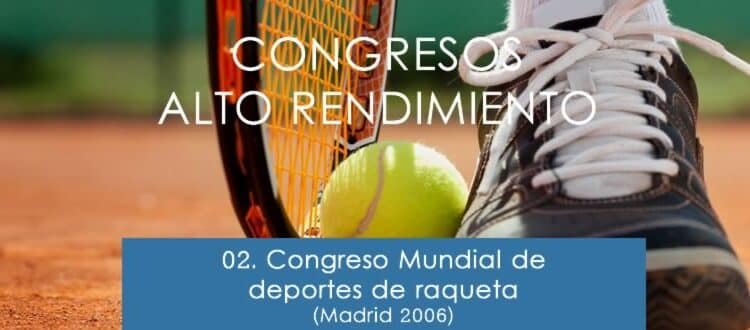Anaerobic performance during intermittent exercise and body composition in group of tennis players in different biological and chronological age
Resumen anaerobic performance during intermittent exercise
Tennis requires coordination, agility, speed, quickness, cardiorespiratory endurance, local muscle endurance, strength and power. Each aspect becomes more important at higher levels of play. The somatic characteristics: body size, structure and composition are significant determinants of athletic success. The focus of this study was to assess the anaerobic performance during intermittent workloads using laboratory and field tests. We were looking for the correlation between anaerobic parameters measured in two tests and body composition: fat mass, fat free mass in group of tennis player in different age. Materials and Methods: Subjects. Eighteen tennis players – all members of Polish Tennis Federation took part in this study. The subjects were divided in four groups depending on age. Experimental protocol : The study consisted of two main parts, which were separated by week. In the first part subjects performed supramaximal cycloergometic exercise 15s Wingate test introduced by Bar Or .This exercise was repeated four times with 45 s rest between each test. After warming up the subject began pedaling as rapidly as possible during 15s against a heavy resistance of 0,74 [N· kg -1] body mass. During the test we measured the following values: value of total work, maximal power output, fatigue index, time to approaching to peak power and time of sustained the peak power. In the second part subjects performed specific tennis drill, which was called by us PUST. This specific drill consisted of subsequent imitation of movements: forehand, backhand, running to the net and volley, and smash. Whole tennis drill was performed without a ball and the speed of an exercise was recorded by photocells. Body composition was estimated by bioimpedential method using Tanita Body Fat Monitor/Scale Analyser TBF-300. Statistic. The statistical analysis was performed by using the software program Statistica 6.0 for Windows. Differences between groups and between each tests was counted by RIR Tukey test. Main findings and conclusions: All groups had the level of fat mass in range 10-18%, which was recommended by Houtkooper and Going. Some authors the higher values of FFM / FM [Free Fat Mass/Fat Mass] associated with better performance of men. In our investigation this relationships was confirmed in only in group with the highest amount of fat -17 year old boys. The correlation between body composition and parameters of anaerobic performance measured during intermittent exercise was observed between lean body mass and values of total work [J·kg-1] only in 15 year old tennis player during second and third test (r= -0,92* , r= -0,92*). There wasn’t correlation between parameters of anaerobic performance and body composition in other groups. Body mass in both groups :18 and 16 year old tennis player affected fatigue index during the third and fourth test. In these groups there were positive IV Congreso Mundial de Ciencia y Deportes de Raqueta correlation r=0,99* and r=0,97* between those parameters. It can suggested that the high body mass increased fatigue index. In groups of chronological age wasn’t correlation between parameters of anaerobic performance measured in two tests. The next step of this study was to determine biological age of those tennis players using graphic method by Cie?lik and compare to chronological age. The chronological age wasn’t adequate to biological in every case. Many tennis players had higher biological age compared to their chronological age. In players whose biological age was 18 in first and second tests, we observed positive correlation between body mass and anaerobic capacity measured in total work [J·kg-1] (r= 0,76*, r=0,75*) and anaerobic power [W·kg-1] (r=0,75*, r=0,77*). This correlation was also noticed in 15 year old boys but only during first test. Parameters characterized anaerobic performance measured during Wingate test correlated with results of PUST but only in groups in biological age.
1. INTRODUCTION
Tennis is a kind of sport characterized by variety of demands on the human body, all depending on the level of play. First of all tennis requires coordination, agility, speed, quickness, cardiorespiratory endurance, local muscle endurance, strength and power. Each aspect becomes more important at higher levels of play. The somatic characteristics: body size, structure and composition are significant determinants of athletic success. Training process of tennis player should develop each one of fitness components, especially anaerobic lactic and alactic metabolic systems but the training workload may be modify by age and gamestyle. A player’sgamestyle and physical characteristics will impact on the type of conditioning work that player will perform. From the age of 14 girls and little bit later with boys trainers can start individualizing physical conditioning programmes according to the game style and physical characteristics as is recommended by ITF. But the question is which kind of age is more important and which one should be taken into consideration: biological or chronological. The focus of this study was to assess the influence of body size and composition on performance in tennis player in different age groups during intermittent workloads. We were looking for the correlation between anaerobic power and capacity and body composition: fat mass, fat free mass. The purpose of the study was to compare selected physiological response during two tests: laboratory and field test.
MATERIALS AND METHODS
Subjects. Eighteen tennis players – all members of Polish Tennis Federation took part in this study. The subjects were divided in four groups depending on age. The study consisted of two main parts, which were separated by 2days. First experimental protocol (laboratory): Subjects performed supramaximal cycloergometic exercise 15s Wingate test introduced by Bar Or [1,2 ].This exercise was repeated four times with 45 s rest between each test. Before the first exercise player performed warm up lasted 3 min. After warming up the subject began pedaling as rapidly as possible during 15s against a heavy resistance of 0,74 [N· kg -1] body mass. The load was applied before the subject started his work. During the test we measured the following values: value of total work, maximal power output, fatigue index, time to approaching to peak power and time of sustained the peak power. Second experimental protocol (field): It was a tennis-specific drill, which is presented on figure 1. We called it PUST and it is connected with first letters of its polish name.A tennis player’s movements were similar to the movements which are made during tennis match (forehand, backhand, volley and smash). This exercise was performed with tennis racquet but without tennis ball. The time of the whole movements was measured by timing gates. This tennis drill was repeated six times with 30 second break after each one drill [5 ].
Figure 1. Move directions during a tennis-specific drill – PUST.
Body composition was estimated by bioimpedential method using Tanita Body Fat Monitor/Scale Analyser TBF-300. Statistic. The statistical analysis was performed by using the software program Statistica 6.0 for Windows. Date are presented as mean values ± standard deviation (SD). Differences between groups and between each tests was counted by RIR Tukey test. Correlations were computed by the Pearson product Moment.
RESULTS
The anthropometric parameters of subjects participated in experiments are shown in table 1. All groups had the level of fat mass in range 10-18%, which was recommended by Houtkooper and Going [7 ].The group of 17 year old boys had the highest level of percentage fat mass, expressed in percentage of body mass and total amount of fat[kg]. The significant difference in fat mass we observed only between two groups of tennis players: 17 and 15 year old. Some authors [8] the higher values of FFM / FM [Free Fat Mass/Fat Mass] associated with better performance of men. In our investigation this relationships was confirmed in only in group with the highest amount of fat. Physiological characteristics of the anaerobic performance during 15s exercise tests in each groups are presented in table 2-5.The smallest difference between first and last test in anaerobic capacity and anaerobic power was observed in group of 16 year old tennis players . The appropriate values were during last exercise 11% and 9,5% lower than in the first one. We observed the smallest differences between parameters of anaerobic capacity measured in first and fourth tests in 16 year old tennis players [table 4] We were looking for the correlation between body composition and parameters of anaerobic performance measured during intermittent exercise. Negative correlation between lean body mass and values of total work [J·kg-1] was noticed only in 15 year old tennis player during second and third test (r= -0,92* , r= -0,92*). There wasn’t correlation between parameters of anaerobic performance and body composition in other groups. Body mass in both groups :18 and 16 year old tennis player affected fatigue index during the third and fourth test. In these groups there were positive correlation r=0,99* and r=0,97* between those parameters. It can suggested that the high body mass increased fatigue index. The next step of this study was to determine biological age of those tennis players using graphic method by Cie?lik and compare to chronological age [3].The chronological age wasn’t adequate to biological in every case. Many tennis players had higher biological age compared to their chronological age. In players whose biological age was 18 -, we observed in first and second tests positive correlation between body mass and anaerobic capacity measured in total work [J·kg-1] (r= 0,76*, r=0,75*) and anaerobic power [W·kg-1] (r=0,75*, r=0,77*). This correlation was also noticed in 15 year old boys but only during first test. Table 7 shows the time of moving a specific tennis drill in each repetition. There weren’t any significant differences between groups. We were looking for the correlation between parameters of anaerobic power and anaerobic capacity (achieved in Wingate test ) and a time of PUST. We didn’t find so strongly correlation between these parameters in chronological age groups but correlation was very expressive only in 18 years old in biological group. Average time of PUST in 18 age biological group was correlated with power [W/kg] in first and last Wingate test (r=-0,85*, r=-0,75*). Each time of repetition PUST correlated with parameters, which were achieved in each Wingate test.
Table 1.
Table 2.
Table 3.
Table 4.
Table 5.
Table 6.
Table 7.
Discussion
The testing of physical abilities visual evaluation of the performance and competition results indicate the effectiveness of training. It is very important notice metabolic changes in development of tennis players. Tennis match play is primarily characterized as acyclic, short time intermittent workloads of the body’s muscular system with extensive and intensive work phases. The energy requirements for tennis match depend on the length of the rally. International Tennis federation’s investigators determined that anaerobic (alactic) system provides 70% and lacidc 20% of all energy expenditure [4, ]. Parameters which characterized anaerobic power and capacity could be measured during Wingate test. Fox [7] suggested training -work interval to improve energy system ATP/PC in relationship: work-rest in ratio 1:3. That is the reason of an applying Wingate 15s and rest 45s in our study. We tried to find correlation between these parameters and a specific tennis drill –PUST. We consider Anaerobac power by measuring ATP-CP system ( W, W/kg, time of sustain and approach) and anaerobic capacity as glycolitic energy system (total work J, J/kg , fatique index) . We noticed this strongly correlation between two tests : in lab and field but only one group- 18 years old –biological age . Our results can suggested that methods of training and workload may be modify by biological age. We observed that body composition influence anaerobic performance. In young players correlation was negative. The higher body mass, the lower anaerobic capacity during repeated exercise. It may be one of the reason of a dissatisfied score of the tennis match. Worse junior’s technical can be compensated by appropriate body composition and high level of anaerobic capacity.
CONCLUSIONS
1. Body composition : lean body mass and fat mass determinate anaerobic capacity in 15 year old tennis players 2. High level of body mass in 18 year old tennis players increased fatigue index. 3. Training enhanced biological age in tennis players 4. We recommended PUST as specific tennis drill, which gave us opportunity to assess anaerobic system in tennis players .
Bibliografía
- 1.Bar-Or O, A new anaerobic capacity test-characteristic and application. Proceedings of the 21st World Congress of Sport Medicine. Brazil, 1978, 1-27
- 2.Bar-Or O., The Wingate Anaerobic test. An update on methodology, reliability and validity. Sports Med. 1987, 4: 381-394
- 3.Cie?lik J., Kaczmarek M.D., Kaliszewska –Drozdowska , Dziecko Pozna?skie ’90, Bogucki Wydawnictwo Naukowe, Pozna?, 1994
- 4.Crespo M., Miley D., ITF Advanced coaches manual, 1998, 9:148-150
- 5. Garsztka T. Relacja pomi?dzy obci??eniemi treningowymi, a meczowymi w tenisie . Konferencja Wychowanie Fizyczne i Sport w badaniach naukowych. AWF Pozna? , 2003
- 6.Ferrauti A., Bergeron M., Pluim B., Weber K., Physiological responses in tennis and running with similar oxygen uptake .European Journal of Applied Physiology, 2001, 85 27-33
- 7.Fox E.L., and Mathews D.K., Interval training : Conditioning for Sports and General Fitness. Philadelphia: W.B. Saundres, 1974
- 8. Houtkooper LB., Going SB., Body composition: how should it be measured ?Does it affect sport performance? Sports Sci Exchange, 1994; 7:1-8
- 9.Wilmore JH. Body weight standards and athletic performance. In: Brownell KD, Rodin J., Wilmore eds. Eating, Body Weight, and performance in Athletes. Philadelphia: Lea & Febiger, 1992:315-29




![Table 1. Anthropometric characteristics of subjects [chronological age]](https://altorendimiento.com/wp-content/uploads/2006/09/Table-1.-Anthropometric-characteristics-of-subjects-chronological-age.jpg)
![Table2. Anthropometric characteristics of subjects [biological age].](https://altorendimiento.com/wp-content/uploads/2006/09/Table2.-Anthropometric-characteristics-of-subjects-biological-age..jpg)








